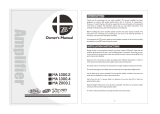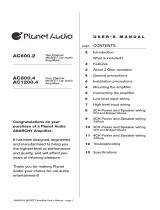Page is loading ...

series
600.2
750.4
1600.1
2000.1 CLASS D MONOBLOCK
MOSFET
POWER AMPLIFIER
2-CH MOSFET
POWER AMPLIFIER
4-CH MOSFET
POWER AMPLIFIER
Oweners Manual
0.1
1
P
PO
W
O
W
1
.1
0
00
0
Limited Warranty:
RE Audio warrants all manufactured electronic products to be free from defects in
material and workmanship for a period not to exceed ONE YEAR from the date of
purchase.
IMPORTANT WARRANTY NOTICE: RE Audio will only warrant and
service products displaying valid RE Audio serial numbers. WAR-
RANTY SERVICE WILL ONLY BE PERFORMED WHEN THE UNIT IS
ACCOMPANIED BY A COPY OF THE ORIGINAL SALES RECEIPT FROM
AN AUTHORIZED DEALER. All product returned to RE Audio for
service MUST be accompanied by a Return Authorization Number,
issued by RE Audio in advance of shipment. The Return Authoriza-
tion Number must be clearly and conspicuously displayed on the
shipping carton or RE Audio will refuse delivery.
For Return Authorization Numbers, first call your RE Audio dealer you purchased the
products from. The dealer will help you to obtain Return Authorization Numbers.
This warranty extends only to the original purchaser and is not transferable. Defective
equipment must be returned within the warranty period, freight prepaid, to the RE
Audio Factory or an Authorized RE Audio Warranty Station.
This warranty covers only detects in materials and workmanship of manufactured
electronic products(amplifiers). Incidents of misuse, abuse, neglect, or unauthorized
modification will not be covered within the terms of this warranty.
RE Audio reserves the right to refuse warranty service under such conditions.
RE Audio WILL NOT BE RESPONSIBLE FOR ANY DAMAGES,
WHETHER INCIDENTAL OR CONSEQUENTIAL, RELATED TO THE USE
OF THIS OR ANY OTHER PRODUCT BEARING OR SOLD UNDER THE
RE Audio BRAND NAME. USE THIS PRODUCT AT YOUR OWN RISK.
IMPROPER USE OF THIS PRODUCT CAN RESULT IN PROPERTY
DAMAGE, BODILY HARM, AND OR OTHER DAMAGE. RE Audio
ASSUMES NO RESPONSIBILITY FOR YOUR HEALTH OR SAFETY.

on your selection of a RE Audio series amplifier.
We take pride in manufacturing our products and you can expect your
new amplifier to give you years of trouble-free service.
To make your installation as easy and reliable as possible, please read this
manual carefully before beginning.
If you need more information, your RE Audio Dealer will be glad to help.
To locate a RE Audio Dealer near you, go to our web site and look for
“Locate Dealer”.
Congratulations
Congratulations / TOC
Read first! / Wiring Instructions
Features & Installation
Basic Wiring
• Monoblock
• 2-channel
• 4-channel
Bridged Wiring
• 2-channel
• 4-channel
Specifications
Troubleshooting
Limited Warranty
1 •••••••••••••
2 •••••••••••••
3 •••••••••••••
4 •••••••••••••
7 •••••••••••••
9 •••••••••••••
10 ••••••••••••
back •••••••••
CONTENTS
1 10
• Re-adjust the Input Level Control to better suit the input signal.
Weak output
•
•
•
•
If the noise is a “whine” whose pitch follows the engine speed, confirm
that the amplifier and any other signal sources (head unit, equalizer, etc)
are properly grounded.
If the noise is a “clicking” or “popping” noise whose rate follows the
engine speed, this usually means that the vehicle is equipped with resis-
tor spark plugs and wires, or that the ignition is in need of service.
Check the routing of the speaker and input wires to make sure they are
not adjacent to wires which interconnect with lights and other accesso-
ries.
If the above steps fail to improve or clear noise interference, the system
should be checked by a authorized RE Audio Dealer.
Noise in the audio
•
•
•
Confirm that all terminal strip connections are secure and tight.
Check the “BALANCE” control on the head unit (or other source) to verify
that it is set to its mid point.
If you are using the low-level RCA input, reverse the input plugs at the
amplifier (switch the R with the L). If the channel which is silent switches
to the other side, the problem is either in the head unit/other source or
the connecting cables.
Only one channel works
Confirm that all terminal strip connections are secure and tight.
Check both in-line and built-in fuses.
Confirm that the audio signal source (car radio, equalizer, etc) is
connected and is supplying output signal. To check if the amplifier is
supplying signal, unplug the RCA cables from the signal source (but
leave them plugged into the amp) and briefly tap the center pin of each
of the disconnected RCA plugs with your finger. This should produce a
noise (feedback) in your speakers.
•
•
•
No Output
Before removing your amplifier, refer to the list below and follow the
suggested procedures. Always test the speakers and their wires first.
TR
OU
BLESH
OO
TIN
G

2
Always read the owners manual before using the equipment
Keep the owners manual in a place where you can easily find it
The amplifier is only for in-vehicle operation
Never use the equipment in the vicinity of heat source and/or in direct sunlight
Make sure that no small objects or liquids can get into the amplifier
Negative bettery terminal must be disconnected before any electrical connections
are made
•
•
•
•
•
•
WIRING INSTRUCTIONS
The battery terminal(+12V) must be connected directly to the positive terminal of the
vehicle’s battery to provide an adequate voltage source and minimize noise. Connecting
the battery terminal lead to any other point(such as the fuse block) will reduce the power
output and may cause noise and distortion. Use only 8 AWG or thicker(smaller AWG) wire
for this lead and connect it to the terminal of the battery after all other wiring is
completed.
Power Connection
The ground terminal(GND) connection is also critical to the correct operation of the
amplifier. Use a wire of the same gauge as the power connection(8 AWG or thicker) and
connect it bwtween the ground terminal(GND) of the amplifier and a metal part of the
vehicle close to the mounting location. This wire should be as short as possible and any
paint or rust at the grounding point should be scraped away to provide a clean metal
surface to which the end of the ground wire can be screwed or bolted.
Ground Connection
The amplifier is turned on by applying +12V to the remote turn-on terminal(REM).
The wire lead to this terminal should be connected to the “Auto-Antenna” lead from the
head unit. If the head unit does not provide an “Auto-Antenna” lead, the remote turn-on
lead may be wired to an “Accessory” or “Radio” terminal in the vehicle’s fust block. This
will turn the amplifier on or off with the ignition key regardless of whether the head unit
is on or off. The remote turn-on lead does not carry large currents. So 20 AWG wire may
be used for this application.
Remote Turn-on Connection
Depending on the type and number of speakers, connect them to the speaker terminals
as shown in the appropriate wiring diagram. For most applications, 16 AWG wire would be
adquated, but in no case thinner than 18 AWG. For leads more than 10 feet long, 14 AWG
is recommended. When wiring the speakers, pay special attention to the polarity of the
terminals. Do not gournd any speaker leads to the chassis of the vehicle.
Speaker Connection
READ FIRST!
It is our recommendation that all RE Audio products should be installed by an autho-
rized dealer.
9
SPECIFICATIONS
Power Output (RMS)
Total Harmonic Distortion
S/N Ratio
Channel Separation @ 4Ω RMS
Power Band Width (Frequency Response)
Crossover Frequency
Bass Boost Control @ 45Hz
Damping Factor
Wired Remote Control
Gain Control
Dimensions [(L) in/mm] (W)8.66/220 x (H)1.93/49
Fuse Rating
Protection (thermal, overload, short circuit, DC offset)
Power Voltage Range
Input
Sensitivity
Input Impedance
4Ω
4Ω
4Ω mono
2Ω
1Ω
Input Short
Low Pass
Low Level
High Level
Subsonic
High Pass
4Ω
@ 14.4V
100Hz
1KHz/100Hz
1KHz/100Hz
1KHz/100Hz
-3dB
24dB
24dB
12dB
mV/V
in/mm
A
V
V
W
W
W
%
dB
Hz
dB
KΩ
Hz
Hz
Hz
2 x 80
2 x 60
<0.02
100
10~50K
22
8.27/210
25A x 1
50~250
50~250
0~12
—
Yes
Yes
11~15V
200
6
—
600.2 750.4
4 x 60
4 x 80
——
2 x 160 — —1 x 160
<0.02
100
10~50K
22
12.2/310
40A x 1
50~250
50~250
0~12
—
180180
Yes
Yes
11~15V
200
6
—
1600.1
1 x 550
1 x 350
1 x 750
< 0.05
100
10~250
22
11.42/290
40A x 2
35~250
—
0~18
180 180
Yes
Yes
Yes
11~15V
200
6
10~50
2000.1
1 x 700
1 x 430
1 x 1000
< 0.05
100
10~250
22
12.2/310
40A x 3
35~250
—
0~18
Yes
Yes
Yes
11~15V
200
6
10~50
* Specification subject to change without notice

8
Impedance: 4-8 Ohm
Impedance: 4-8 Ohm
Power & Speaker Connection
Ch2
Ch1
Ch4
Ch3
from OUTPUT of HEAD UNIT
RCA Connection
4-channel [DTX-750.4] Amplifiers
[Bridged Wiring]
CONNECTIONS
3
• Class D Operation(1600.1/2000.1), Class AB Operation(600.2/750.4)
• MOSFET PWM(Pulse Width Modulation) Power Supply
• Bridgeable Outputs, Tri-mode Capable(600.2/750.4)
• 1 Ohm Stable Mono Operation(1600.1/2000.1)
• 2 Ohm Stable Sterep Operation with Output Increase(600.2/750.4)
• Thermal, DC Offset, Overload, and Speaker Short Protection
• Soft Turn-on Circuit
• Variable Input Gain Control
• Variable Subsonic Filter(1600.1/2000.1)
• Variable Low-pass Crossover
• Variable High-pass Crossover(600.2/750.4)
• Variable 0˚ to 180˚ Phase Shift(1600.1/2000.1)
• Variable 0 to +18dB Bass Boost(1600.1/2000.1), 0 to +12dB Bass Boost(600.2/750.4)
• LED Power and Protection Indicators
• Remote Subwoofer Level Control(1600.1/2000.1)
FEATURES
Please choose a mounting place without any direct weather influences
Note that the amplifier generates heat so a well ventilated place is necessary
Use at least 8-gauge wire for power and ground connections
Use at least 12-gauge wire for speaker connections
Use at least 16-gauge wire for remote connections
Keep the wire connections as short as possible in order to minimize power loss and
provide a higher audio out quality
Use the shortest ground connection to the chassis of the vehicle and make sure that
the paint is removed at the connection point
Connect the remote input to the remote/antenna output of the head unit
Mount the fuse holder within 200mm(8”) of the vehicle’s battery. Use a fuse equal to
that specified for your amplifier if a large, single +12V line is run which feeds more
than one amplifier add up all required fuse ratings and use the total rating for the
fuse
Connect the speaker to the amplifier observing the correct phasing.
Make sure that none of the speaker connections can touch the vehicle chassis
Connect the RCA inputs to the appropriate signal source using only the highest
quality RCA cables
Make sure that the RCA and speaker cables do not run parallel to the +12V wiring
•
•
•
•
•
•
•
•
•
•
•
•
•
INSTALLATION

7
from REMOTE OUTPUT
of HEAD UNIT
BATTERY
GROUND
Impedance: 4-8Ohm
Power & Speaker Connection
from OUTPUT of HEAD UNIT
RCA Connection
2-channel [DTX-600.2] Amplifiers
[Bridged Wiring]
CONNECTIONS
4
from REMOTE OUTPUT
of HEAD UNIT
BATTERY
GROUND
Power & Speaker Connection
2-4 Ohm Subwoofer
from OUTPUT of HEAD UNIT
RCA Connection
Monoblock [DTX-1600.1 & 2000.1] Amplifiers
[Basic Wiring]
CONNECTIONS

5
from REMOTE OUTPUT
of HEAD UNIT
BATTERY
GROUND
Impedance: 2-4 Ohm
Power & Speaker Connection
from OUTPUT of HEAD UNIT
Ch2
Ch1
RCA Connection
2-channel [DTX-600.2] Amplifiers
[Basic Wiring]
CONNECTIONS
6
Impedance: 2-4 Ohm
Impedance: 2-4 Ohm
Power & Speaker Connection
Ch2
Ch1
Ch4
Ch3
from OUTPUT of HEAD UNIT
RCA Connection
4-channel [DTX-750.4] Amplifiers
[Basic Wiring]
CONNECTIONS
/



